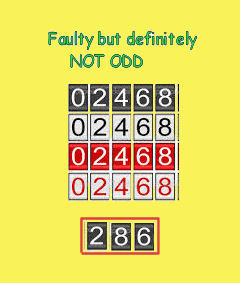Faulty, but definitely not ODD!
 This odometer will not register an odd digit. It always skips an odd digit and replaces it with the following even digit.
This odometer will not register an odd digit. It always skips an odd digit and replaces it with the following even digit.
What is the true reading if this faulty non-odd odometer registers 286?
The answer is 48.
This section requires Javascript.
You are seeing this because something didn't load right. We suggest you, (a) try
refreshing the page, (b) enabling javascript if it is disabled on your browser and,
finally, (c)
loading the
non-javascript version of this page
. We're sorry about the hassle.
Decrease each digit by the number of odds less than itself. We get 143.
This is to be taken as in base 5 because there are only 5 digits in the system.
Then express this as a number in base 10 and you get 1 x 5^2 + 4 x 5^1 + 3 x 5^0 which equals 48.